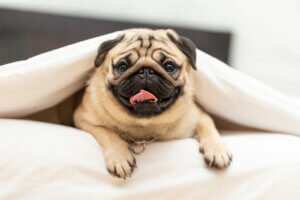What Causes Brachycephaly in Dogs?


Written and verified by the biologist Francisco Morata Carramolino
Humans have altered the appearance of many of the animals we share our lives with through artificial selection and the process of domestication. Brachycephaly in dogs is caused by these breeding processes.
As you can see, we’re responsible for many of the current breeds as we created them for functional reasons. Beasts of burden and those used in livestock breeding for instance. There are aesthetic reasons as well, as is the case with many pets. Unfortunately, some of the transformations we’ve subjected animals to have had negative consequences on their health.
The brachycephaly sustained by several breeds of dogs, as well as other animals is a clear case of this. Continue reading to find out more about the cause.
Characteristics of brachycephaly in dogs
Brachycephaly is a modification of the proportions of the canine’s head so that the length of the skull is less than its width. This results in a rounded or flattened head, with a short muzzle. It’s usually associated with dogs such as the pug or bulldog but it’s also present in cats, rabbits, and pigs.
This condition is also associated with multiple health problems, such as breathing complications, cleft palate, an increased risk of gliomas, and many other diseases. For this reason, brachycephalic dogs require specific care.
These breeds have existed for much of human history. In fact, remains of brachycephalic dogs have been found from Roman times, during archaeological studies in the Pompeii ruins.

Evolution modifies animals
This is the change in the genetic traits of a population over generations and doesn’t pursue an ultimate goal when it occurs in nature. This is because natural selection is its primary mediator. However, humans found ways to control it to their advantage.
Natural selection as an evolutionary driver
This is key when talking about evolution as there’s intrinsic variability in living populations. Some animals almost always have different characteristics than others within a group. These variations make some more capable of surviving in their environment than others.
A higher percentage of animals with traits more appropriate to the environment survive. Therefore, they reproduce more than those with non-viable characteristics and produce more offspring. As the generations go by, those advantageous traits become more prevalent. We know this as evolution by natural selection.
Artificial selection – evolution at will
Contrary to the previous one, there’s also evolution by artificial selection. Humans control it in pursuit of an ultimate goal. Instead of selecting the characteristics that make them survive, humans choose the animal qualities they consider most desirable.
Once we make a selection, we allow those animals to reproduce and it results in offspring with those specific qualities. Then, we repeat the process for generations until the breeders like the result: this is precisely the cause of brachycephaly in dogs.
Artificial selection as a cause of brachycephaly in dogs
Originally, we selected dogs with less elongated skulls for fights. This is because these dogs have stronger bites. Thus, we progressively selected those with this trait and exaggerated it over the generations until brachycephaly occurred.
This process continues to the present day and only accentuates brachycephaly but the reason behind it changed over the years and is now purely aesthetic. The rounded head of these animals instinctively reminds us of that of small children. This is why some of us find it pleasant as it arouses our protective side.
Moreover, with the advance of veterinary techniques, we’ve gone from selecting and crossing animals only to using techniques such as artificial insemination and C-section. This makes it possible to produce offspring of breeds that would’ve never reproduced naturally due to their physical limitations.
Unfortunately, we’ve exaggerated this trait to such an extent that it now causes serious animal health problems. Brachycephalic breeds have more diseases, poorer quality of life, and require more veterinary interventions than other breeds.
Their condition is such that they’re recommending discontinuing some of these breeds.

As you can see, artificial selection has had unfortunate consequences but it’s also been an indispensable part of the history of humans and their environment. It’s responsible for the emergence of domestic animals and the creation of many of the products we consume today.
Humans have altered the appearance of many of the animals we share our lives with through artificial selection and the process of domestication. Brachycephaly in dogs is caused by these breeding processes.
As you can see, we’re responsible for many of the current breeds as we created them for functional reasons. Beasts of burden and those used in livestock breeding for instance. There are aesthetic reasons as well, as is the case with many pets. Unfortunately, some of the transformations we’ve subjected animals to have had negative consequences on their health.
The brachycephaly sustained by several breeds of dogs, as well as other animals is a clear case of this. Continue reading to find out more about the cause.
Characteristics of brachycephaly in dogs
Brachycephaly is a modification of the proportions of the canine’s head so that the length of the skull is less than its width. This results in a rounded or flattened head, with a short muzzle. It’s usually associated with dogs such as the pug or bulldog but it’s also present in cats, rabbits, and pigs.
This condition is also associated with multiple health problems, such as breathing complications, cleft palate, an increased risk of gliomas, and many other diseases. For this reason, brachycephalic dogs require specific care.
These breeds have existed for much of human history. In fact, remains of brachycephalic dogs have been found from Roman times, during archaeological studies in the Pompeii ruins.

Evolution modifies animals
This is the change in the genetic traits of a population over generations and doesn’t pursue an ultimate goal when it occurs in nature. This is because natural selection is its primary mediator. However, humans found ways to control it to their advantage.
Natural selection as an evolutionary driver
This is key when talking about evolution as there’s intrinsic variability in living populations. Some animals almost always have different characteristics than others within a group. These variations make some more capable of surviving in their environment than others.
A higher percentage of animals with traits more appropriate to the environment survive. Therefore, they reproduce more than those with non-viable characteristics and produce more offspring. As the generations go by, those advantageous traits become more prevalent. We know this as evolution by natural selection.
Artificial selection – evolution at will
Contrary to the previous one, there’s also evolution by artificial selection. Humans control it in pursuit of an ultimate goal. Instead of selecting the characteristics that make them survive, humans choose the animal qualities they consider most desirable.
Once we make a selection, we allow those animals to reproduce and it results in offspring with those specific qualities. Then, we repeat the process for generations until the breeders like the result: this is precisely the cause of brachycephaly in dogs.
Artificial selection as a cause of brachycephaly in dogs
Originally, we selected dogs with less elongated skulls for fights. This is because these dogs have stronger bites. Thus, we progressively selected those with this trait and exaggerated it over the generations until brachycephaly occurred.
This process continues to the present day and only accentuates brachycephaly but the reason behind it changed over the years and is now purely aesthetic. The rounded head of these animals instinctively reminds us of that of small children. This is why some of us find it pleasant as it arouses our protective side.
Moreover, with the advance of veterinary techniques, we’ve gone from selecting and crossing animals only to using techniques such as artificial insemination and C-section. This makes it possible to produce offspring of breeds that would’ve never reproduced naturally due to their physical limitations.
Unfortunately, we’ve exaggerated this trait to such an extent that it now causes serious animal health problems. Brachycephalic breeds have more diseases, poorer quality of life, and require more veterinary interventions than other breeds.
Their condition is such that they’re recommending discontinuing some of these breeds.

As you can see, artificial selection has had unfortunate consequences but it’s also been an indispensable part of the history of humans and their environment. It’s responsible for the emergence of domestic animals and the creation of many of the products we consume today.
All cited sources were thoroughly reviewed by our team to ensure their quality, reliability, currency, and validity. The bibliography of this article was considered reliable and of academic or scientific accuracy.
Bannasch, D., Young, A., Myers, J., Truvé, K., Dickinson, P., Gregg, J., … & Pedersen, N. 2010. Localization of canine brachycephaly using an across breed mapping approach. PLOS ONE. 5: e9632.
Zedda, M., Manca, P., Chisu, V., Gadau, S., Lepore, G., Genovese, A., & Farina, V. 2006. Ancient pompeian dogs–morphological and morphometric evidence for different canine populations. Anatomia, histologia, embryologia. 35: 319-324.
Packer, R. M., O’Neill, D. G., Fletcher, F., & Farnworth, M. J. 2019. Great expectations, inconvenient truths, and the paradoxes of the dog-owner relationship for owners of brachycephalic dogs. PLOS ONE. 14: e0219918.
This text is provided for informational purposes only and does not replace consultation with a professional. If in doubt, consult your specialist.








